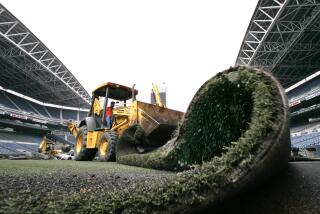With Lawns of the Future, Mow Will Be Less
- Share via
Two guys from the old neighborhood run into each other after years in the suburbs.
“So how do you like it out here, Sam?”
“I’ll tell you, Bill. I felt sort of overwhelmed until I got myself a paramour.”
“A paramour? Does your wife know?”
“Of course she knows.”
“And she doesn’t mind that you have a paramour?”
“Why would she mind what I cut the grass with?”
Come the new millennium, this is one dumb joke that will wither away and die.
For one thing, the new millennium will not be kind to dumb jokes. At 12:01 a.m. on Jan. 1, jackbooted, bullet-eyed U.N. troops will leap out of black helicopters to round up the dumb jokes and send them to camps for recycling as e-mails from World Central Command.
But, more significantly: In the new millennium, there will be no lawns as we know them. The patch of green surrounding your piece of heaven will grow only a bit faster than Astroturf. Cobwebs will clog your mower and trap your gardener, and the authorities will have to pry him out with the Jaws of Life.
That’s the startling conclusion of a paper in this week’s “Proceedings of the National Academy of Sciences.”
The paper outlines the discovery of a “dwarf gene” that limits plant growth. Monkeying around with this gene, researchers grew a mature, healthy tobacco plant that topped out at a measly 12 inches. Normal tobacco plants reach 6 feet.
Michael Neff, the paper’s principal author, said he came up with the idea while--what else?--mowing his lawn. Grass that requires almost no mowing could be on its way to a plot near you in about a year, he said.
That might sound liberating, but I hope the geneticists take a deep breath and slow down. Maybe then they’ll recognize the weirdness of a silent suburb, not deafened by mowers and blowers.
In a world of slow-growth lawns, children will see lawn mowers and authentic, unfettered grass only in places that cling to their quaint 20th century customs for the sake of tourists.
“Mom, that guy’s using a 486 computer!” Junior will shout as he tours Ye Olde Ranch House. “And at 3 p.m., he’s supposed to use one of those big honkin’ mowers on an old-fashioned front lawn!”
The concept of mowing will disappear. Algebra teachers will have to come up with something besides: “If John can mow a lawn in two hours and Bill can mow the same lawn in three hours, how long will it take the two of them to knock off a six-pack before they head for the movies?”
And those are the minor pitfalls. If science can give us lovely lawns that barely grow, the next step is freezing dogs in puppyhood, and then maybe keeping children locked in preteen innocence for about 250 years. Many a slippery slope can be planted with genetically engineered grass, but, if you’re a real slow-growther, there’s no reason to stop with sod.
Of course, there are skeptics.
Tony Prater is the marketing director for Pacific Earth Resources, a Camarillo firm that grows 900 acres of emerald-green sod for subdivisions, golf courses, and even the Rose Bowl.
“There’s been all kinds of development and testing and research, but so far the industry has yet to come up with varieties of grass that require very little mowing,” he said.
Experimental slow-mow grasses don’t bounce back from wear very easily, he said. And in the winter, they brown like pork sausage--a far cry from “the nice, year-round, uniform, deep-green, plush look that most Southern Californians are looking for.”
So what new developments can we look forward to, at the grass-roots level, I asked Prater.
“The Mow-lennium,” he said.
*
Steve Chawkins can be reached at 653-7561 or at steve.chawkins@latimes.com.
More to Read
Sign up for Essential California
The most important California stories and recommendations in your inbox every morning.
You may occasionally receive promotional content from the Los Angeles Times.














